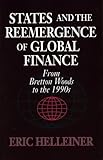States and the Reemergence of Global Finance : From Bretton Woods to the 1990s / Eric Helleiner.
Material type: TextPublisher: Ithaca, NY : Cornell University Press, [1994]Copyright date: ©2015Description: 1 online resource (258 p.)Content type:
TextPublisher: Ithaca, NY : Cornell University Press, [1994]Copyright date: ©2015Description: 1 online resource (258 p.)Content type: - 9781501701986
- 332.042 22
- HG3881 .H418 1994eb
- online - DeGruyter
| Item type | Current library | Call number | URL | Status | Notes | Barcode | |
|---|---|---|---|---|---|---|---|
 eBook
eBook
|
Biblioteca "Angelicum" Pont. Univ. S.Tommaso d'Aquino Nuvola online | online - DeGruyter (Browse shelf(Opens below)) | Online access | Not for loan (Accesso limitato) | Accesso per gli utenti autorizzati / Access for authorized users | (dgr)9781501701986 |
Browsing Biblioteca "Angelicum" Pont. Univ. S.Tommaso d'Aquino shelves, Shelving location: Nuvola online Close shelf browser (Hides shelf browser)

|

|

|

|

|

|

|
||
| online - DeGruyter The End of the West? : Crisis and Change in the Atlantic Order / | online - DeGruyter The National Question in Yugoslavia : Origins, History, Politics / | online - DeGruyter "I'm Not a Racist, But." : The Moral Quandary of Race / | online - DeGruyter States and the Reemergence of Global Finance : From Bretton Woods to the 1990s / | online - DeGruyter Modern Hatreds : The Symbolic Politics of Ethnic War / | online - DeGruyter John Dewey and American Democracy / | online - DeGruyter Democratic Hope : Pragmatism and the Politics of Truth / |
Frontmatter -- Contents -- Preface -- Abbreviations -- 1. Introduction -- PART I. THE RESTRICTIVE BRETTON WOODS FINANCIAL ORDER -- 2. Bretton Woods and the Endorsement of Capital Controls -- 3. Continuing Caution: The Slow and Limited Move to Convertibility -- PART II. THE REEMERGENCE OF GLOBAL F INANCE -- 4. Support for the Euromarket in the 1960s -- 5. Failed Cooperation in the Early 1970S -- 6. Four Turning Points in the Late 1970S and Early 1980s -- 7. The Liberalization Trend in the 1980s -- 8. Weathering International Financial Crises -- PART III. CONCLUSION -- 9. Explaining Differing State Behavior in Trade and Finance -- Works Cited -- Index
restricted access online access with authorization star
http://purl.org/coar/access_right/c_16ec
Most accounts explain the postwar globalization of financial markets as a product of unstoppable technological and market forces. Drawing on extensive historical research, Eric Helleiner provides the first comprehensive political history of the phenomenon, one that details and explains the central role played by states in permitting and encouraging financial globalization.Helleiner begins by highlighting the commitment of advanced industrial states to a restrictive international financial order at the 1944 Bretton Woods conference and during the early postwar years. He then explains the growing political support for the globalization of financial markets after the late 1950s by analyzing five sets of episodes: the creation of the Euromarket in the 1960s, the rejection in the early 1970s of proposals to reregulate global financial markets, four aborted initiatives in the late 1970s and early 1980s to implement effective controls on financial movements, the extensive liberalization of capital controls in the 1980s, and the containment of international financial crises at three critical junctures in the 1970s and 1980s.He shows that these developments resulted from various factors, including the unique hegemonic interests of the United States and Britain in finance, a competitive deregulation dynamic, ideological shifts, and the construction of a crisis-prevention regime among leading central bankers. In his conclusion Helleiner addresses the question of why states have increasingly embraced an open, liberal international financial order in an era of considerable trade protectionism.
Mode of access: Internet via World Wide Web.
In English.
Description based on online resource; title from PDF title page (publisher's Web site, viewed 26. Apr 2024)


